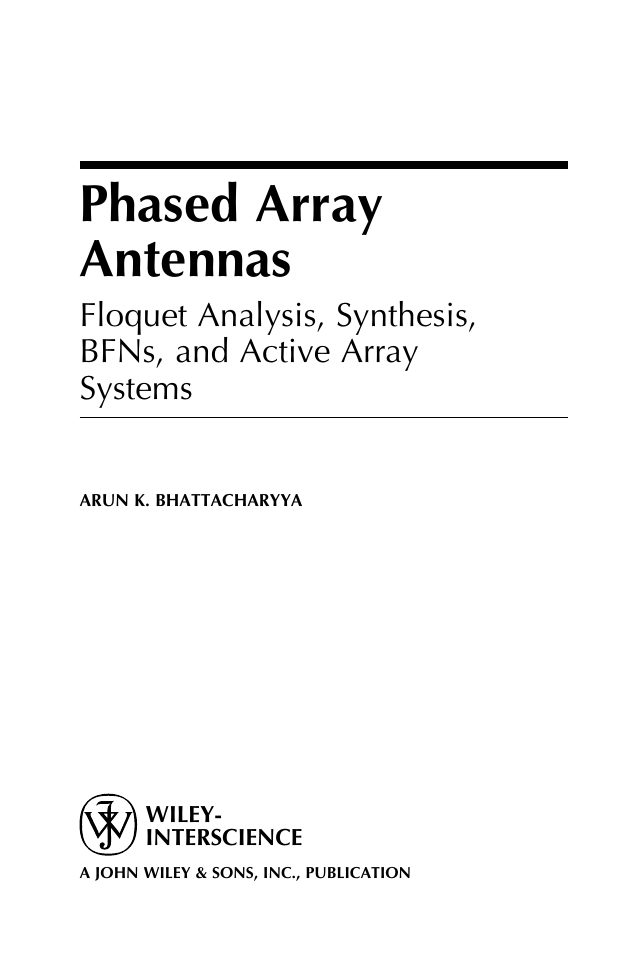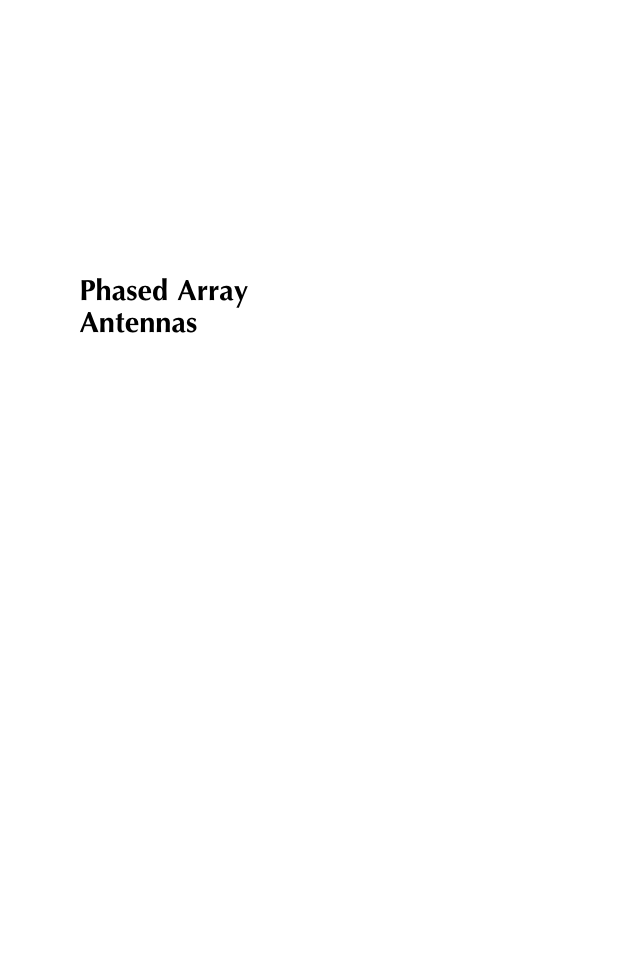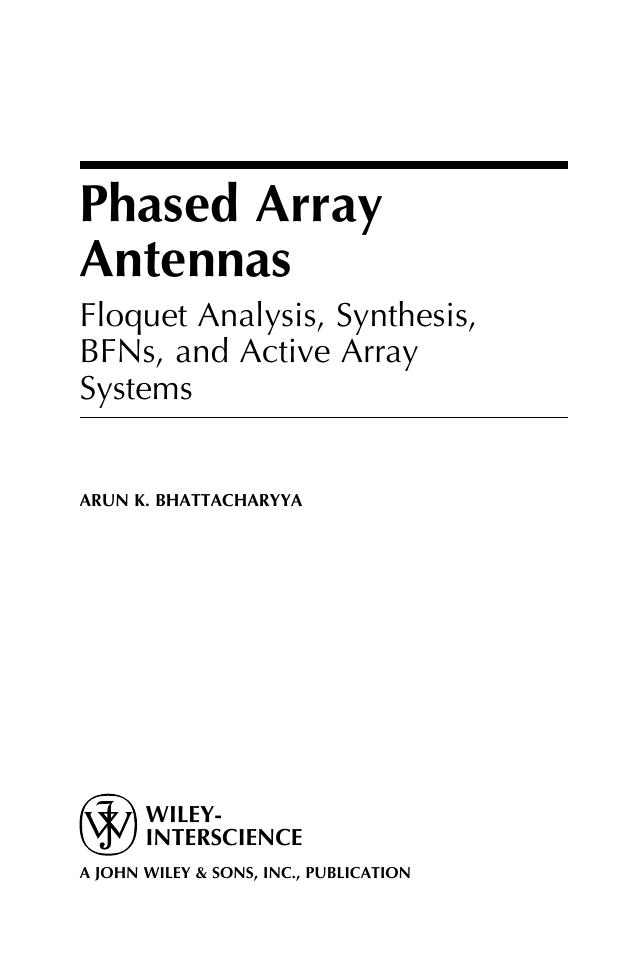Phased Array Antennas
Contents
Preface
1 Phased Array Fundamentals: Pattern Analysis and Synthesis
1.1 Introduction
1.2 Array Fundamentals
1.2.1 Element Pattern, Directivity, and Gain
1.2.2 Copolarization and Cross-Polarization
1.2.3 Array Pattern
1.2.4 Array Gain
1.2.5 Maximum-Array-Gain Theorem
1.2.6 Array Taper Efficiency
1.3 Pencil Beam Array
1.3.1 Scan Loss and Beam Broadening
1.3.2 Scan Array Design Consideration
1.3.3 Grating Lobes
1.3.4 Fixed-Value Phase Shifter Versus True Time Delay Phase Shifter
1.3.5 Phase Quantization
1.4 Linear Array Synthesis
1.4.1 Array Factor: Schelkunoff’s Polynomial Representation
1.4.2 Binomial Array
1.4.3 Dolph–Chebyshev Array
1.4.4 Taylor Line Source Synthesis
1.4.5 Bayliss Difference Pattern Synthesis
1.5 Planar Aperture Synthesis
1.5.1 Taylor’s Circular Aperture Synthesis
1.5.2 Bayliss Difference Pattern Synthesis
1.6 Discretization of Continuous Sources
1.7 Summary
References
Bibliography
Problems
2 Introduction to Floquet Modes in Infinite Arrays
2.1 Introduction
2.2 Fourier Spectrum and Floquet Series
2.2.1 Fourier Transform
2.2.2 Periodic Function: Fourier Series
2.2.3 Floquet Series
2.2.4 Two-Dimensional Floquet Series
2.3 Floquet Excitations and Floquet Modes
2.3.1 Main Beam and Gratings
2.4 Two-Dimensional Floquet Excitation
2.4.1 Circle Diagram: Rectangular Grids
2.4.2 Circle Diagram: Isosceles Triangular Grids
2.5 Grating Beams from Geometrical Optics
2.6 Floquet Mode and Guided Mode
2.7 Summary
References
Problems
3 Floquet Modal Functions
3.1 Introduction
3.2 TE(z) and TM(z) Floquet Vector Modal Functions
3.2.1 TE(z) Floquet Modal Fields
3.2.2 TM(z) Floquet Modal Fields
3.3 Infinite Array of Electric Surface Current on Dielectric-Coated Ground Plane
3.3.1 TE(zmn) and TM(zmn) Modal Source Decomposition
3.3.2 TE(zmn) Fields
3.3.3 TM(zmn) Fields
3.3.4 Floquet Impedance
3.4 Determination of Blind Angles
3.5 Active Element Pattern
3.5.1 Array Pattern Using Superposition
3.5.2 Array Pattern Using Floquet Modal Expansion
3.5.3 Active Element Gain Pattern
3.6 Array of Rectangular Horn Apertures
3.6.1 Waveguide Modes
3.6.2 Waveguide Modes to Floquet Modes
3.6.3 Reflection and Transmission Matrices
3.6.4 TE(10) Mode Incidence
References
Bibliography
Problems
4 Finite Array Analysis Using Infinite Array Results: Mutual Coupling Formulation
4.1 Introduction
4.2 Symmetry Property of Floquet Impedance
4.2.1 Admittance Seen by Floquet Modal Source
4.2.2 Aperture Admittance
4.3 Mutual Coupling
4.3.1 Mutual Impedance
4.3.2 Mutual Admittance
4.3.3 Scattering Matrix Elements
4.4 Array of Multimodal Sources
4.5 Mutual Coupling in Two-Dimensional Arrays
4.5.1 Rectangular Lattice
4.5.2 Arbitrary Lattice
4.6 Active Input Impedance of Finite Array
4.6.1 Nonexcited Elements Open Circuited
4.6.2 Nonexcited Elements Short Circuited
4.6.3 Nonexcited Elements Match Terminated
4.7 Active Return Loss of Open-Ended Waveguide Array
4.8 Radiation Patterns of Finite Array
4.8.1 Nonexcited Elements Open Circuited
4.8.2 Nonexcited Elements Short Circuited
4.8.3 Nonexcited Elements Match Terminated
4.9 Radiation Patterns of Open-Ended Waveguide Array
4.10 Array with Nonuniform Spacing
4.11 Finite Array Analysis Using Convolution
4.11.1 Convolution Relation for Aperture Field
4.11.2 Mutual Impedance
References
Bibliography
Problems
5 Array of Subarrays
5.1 Introduction
5.2 Subarray Analysis
5.2.1 Subarray Impedance Matrix: Eigenvector Approach
5.3 Subarray with Arbitrary Number of Elements
5.4 Subarrays with Arbitrary Grids
5.5 Subarray and Grating Lobes
5.6 Active Subarray Patterns
5.7 Four-Element Subarray Fed by Power Divider
5.7.1 E-Plane Subarray
5.7.2 H-Plane Subarray
5.8 Subarray Blindness
5.9 Concluding Remarks
References
Bibliography
Problems
6 GSM Approach for Multilayer Array Structures
6.1 Introduction
6.2 GSM Approach
6.3 GSM Cascading Rule
6.4 Transmission Matrix Representation
6.5 Building Blocks for GSM Analysis
6.5.1 Dielectric Layer
6.5.2 Dielectric Interface
6.5.3 Array of Patches
6.6 Equivalent Impedance Matrix of Patch Layer
6.7 Stationary Character of MoM Solutions
6.7.1 Stationary Expression
6.7.2 GSM from Stationary Expression
6.8 Convergence of MoM Solutions
6.8.1 Selection of Number of Coupling Modes
6.8.2 Failure of MoM Analysis
6.8.3 Lower Limit for Number of Expansion Modes
6.8.4 Number of Basis Functions
6.9 Advantages of GSM Approach
6.10 Other Numerical Methods
References
Bibliography
Problems
7 Analysis of Microstrip Patch Arrays
7.1 Introduction
7.2 Probe-Fed Patch Array
7.2.1 Generalized Impedance Matrix of Probe Layer
7.2.2 Input Impedance
7.2.3 Impedance Characteristics
7.2.4 Active Element Patterns
7.3 EMC Patch Array
7.4 Slot-Fed Patch Array
7.4.1 Microstripline–Slot Transition
7.4.2 Input Impedance
7.4.3 Active Element Patterns
7.5 Stripline-Fed Slot-Coupled Array
7.6 Finite Patch Array
References
Bibliography
Problems
8 Array of Waveguide Horns
8.1 Introduction
8.2 Linearly Flared Horn Array
8.2.1 Return Loss Characteristics
8.2.2 Active Element Pattern
8.3 Grazing Lobes and Pattern Nulls
8.3.1 Aperture Admittance Formulation
8.3.2 Equivalent Circuit
8.3.3 Reflection Loss at Grazing Lobe Condition
8.4 Surface and Leaky Waves in an Array
8.4.1 Surface Wave
8.4.2 Leaky Wave
8.4.3 Supergain Phenomenon
8.5 Wide-Angle Impedance Matching
8.5.1 WAIM: Input Admittance Perspective
8.6 Multimodal Rectangular/Square Horn Elements
8.6.1 Potter Horn
8.6.2 High-Efficiency Horn
8.7 Multimodal Circular Horn Elements
References
Bibliography
Problems
9 Frequency-Selective Surface, Polarizer, and Reflect-Array Analysis
9.1 Introduction
9.2 Frequency-Selective Surface
9.2.1 Reflection and Transmission Characteristics
9.2.2 Cross-Polarization Performance
9.2.3 FSS-Loaded Antenna
9.3 Screen Polarizer
9.3.1 Analysis
9.3.2 Meander Susceptance
9.3.3 Return Loss and Axial Ratio
9.3.4 Scan Characteristics
9.4 Printed Reflect Array
9.4.1 Phase Characteristics
9.4.2 Design and Performance
9.4.3 Circular Polarization
9.4.4 Bandwidth Enhancement
9.4.5 Contour-Beam Reflect Array
References
Bibliography
Problems
10 Multilayer Array Analysis with Different Periodicities and Cell Orientations
10.1 Introduction
10.2 Layers with Different Periodicities: Rectangular Lattice
10.2.1 Patch-Fed Patch Subarray
10.3 Nonparallel Cell Orientations: Rectangular Lattice
10.3.1 Patch Array Loaded with Screen Polarizer
10.4 Layers with Arbitrary Lattice Structures
10.5 Summary
References
Bibliography
Problems
11 Shaped-Beam Array Design: Optimization Algorithms
11.1 Introduction
11.2 Array Size: Linear Array
11.3 Element Size
11.4 Pattern Synthesis Using Superposition (Woodward’s Method)
11.5 Gradient Search Algorithm
11.5.1 Mathematical Foundation
11.5.2 Application of GSA for Array Synthesis
11.5.3 Phase-Only Optimization
11.5.4 Contour Beams Using Phase-Only Optimization
11.6 Conjugate Match Algorithm
11.7 Successive Projection Algorithm
11.7.1 Successive Projection and Conjugate Match
11.8 Other Optimization Algorithms
11.9 Design Guidelines of a Shaped Beam Array
References
Bibliography
Problems
12 Beam Forming Networks in Multiple-Beam Arrays
12.1 Introduction
12.2 BFN Using Power Dividers
12.3 Butler Matrix Beam Former
12.3.1 Orthogonal Beams
12.3.2 Fourier Transform and Excitation Coefficients
12.3.3 FFT Algorithm
12.3.4 FFT and Butler Matrix
12.3.5 Hybrid Matrix
12.3.6 Modified Butler BFN for Nonuniform Taper
12.3.7 Beam Port Isolation
12.3.8 Three-Dimensional BFN
12.4 Blass Matrix BFN
12.5 Rotman Lens
12.5.1 Rotman Surface Design
12.5.2 Numerical Results
12.5.3 Physical Implementation
12.5.4 Scattering Matrix
12.6 Digital Beam Former
12.6.1 Digital Phase Shifter
12.6.2 System Characteristics
12.7 Optical Beam Formers
References
Bibliography
Problems
13 Active Phased Array Antenna
13.1 Introduction
13.2 Active Array Block Diagrams
13.3 Aperture Design of Array
13.3.1 Number of Elements and Element Size
13.3.2 Radiating Element Design Consideration
13.4 Solid State Power Amplifier
13.4.1 System Characteristics
13.5 Phase Shifter
13.6 Intermodulation Product
13.6.1 Estimation of SSPA Parameters from IM Data
13.6.2 IM Beam Locations
13.6.3 Multiple-Channel Array: Noise Power Ratio
13.6.4 AM–PM Conversion
13.7 Noise Temperature and Noise Figure of Antenna Subsystems
13.7.1 Antenna Noise Temperature
13.7.2 Noise Temperature and Noise Figure of Resistive Circuits
13.8 Active Array System Analysis
13.9 Active Array Calibration
13.9.1 Two-Phase-State Method
13.9.2 Multiple-Phase Toggle Method
13.9.3 Simultaneous Measurement: Hadamard Matrix Method
13.10 Concluding Remarks
References
Bibliography
Problems
14 Statistical Analysis of Phased Array Antenna
14.1 Introduction
14.2 Array Pattern
14.3 Statistics of R and I
14.4 Probability Density Function of |F(u)|
14.4.1 Central Limit Theorem
14.4.2 PDF of R and I
14.4.3 PDF of R(2)+I(2)
14.5 Confidence Limits
14.5.1 Beam Peak
14.5.2 Side Lobe
14.5.3 Nulls
14.6 Element Failure Analysis
14.7 Concluding Remarks
References
Bibliography
Problems
Appendix
Index
















 2023年江西萍乡中考道德与法治真题及答案.doc
2023年江西萍乡中考道德与法治真题及答案.doc 2012年重庆南川中考生物真题及答案.doc
2012年重庆南川中考生物真题及答案.doc 2013年江西师范大学地理学综合及文艺理论基础考研真题.doc
2013年江西师范大学地理学综合及文艺理论基础考研真题.doc 2020年四川甘孜小升初语文真题及答案I卷.doc
2020年四川甘孜小升初语文真题及答案I卷.doc 2020年注册岩土工程师专业基础考试真题及答案.doc
2020年注册岩土工程师专业基础考试真题及答案.doc 2023-2024学年福建省厦门市九年级上学期数学月考试题及答案.doc
2023-2024学年福建省厦门市九年级上学期数学月考试题及答案.doc 2021-2022学年辽宁省沈阳市大东区九年级上学期语文期末试题及答案.doc
2021-2022学年辽宁省沈阳市大东区九年级上学期语文期末试题及答案.doc 2022-2023学年北京东城区初三第一学期物理期末试卷及答案.doc
2022-2023学年北京东城区初三第一学期物理期末试卷及答案.doc 2018上半年江西教师资格初中地理学科知识与教学能力真题及答案.doc
2018上半年江西教师资格初中地理学科知识与教学能力真题及答案.doc 2012年河北国家公务员申论考试真题及答案-省级.doc
2012年河北国家公务员申论考试真题及答案-省级.doc 2020-2021学年江苏省扬州市江都区邵樊片九年级上学期数学第一次质量检测试题及答案.doc
2020-2021学年江苏省扬州市江都区邵樊片九年级上学期数学第一次质量检测试题及答案.doc 2022下半年黑龙江教师资格证中学综合素质真题及答案.doc
2022下半年黑龙江教师资格证中学综合素质真题及答案.doc